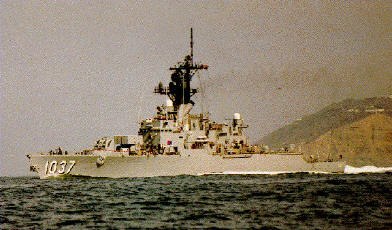 Considered the first of the "Second Generation" of post-WWII
Destroyer Escorts, only two of this class of DE or frigates as they were
later classified in 1975, were built, that being the BRONSTEIN and sister ship
McCLOY. These two ships can be considered "developmental" vessels as many new
systems were tested for future use, such as the hull design, larger bow-mounted
SQS-26AX sonar system, and ASW weaponry. While they were new construction ships
of FY 1960, that construction was included in the FRAM program as
these two ships were built, from the keel-up, with the
FRAM improvements and to specifically operate DASH, have the SQS-26 sonar system
for target acquisition and all the other improvements that FRAM-1 brought to
the Gearings, Sumner and Fletcher class destroyers. The Bronstein class
ships operated the QH-50C DASH from commissioning and after their sonar
upgrade to the SQS-26AX(R), received the QH-50D variant of DASH.
Considered the first of the "Second Generation" of post-WWII
Destroyer Escorts, only two of this class of DE or frigates as they were
later classified in 1975, were built, that being the BRONSTEIN and sister ship
McCLOY. These two ships can be considered "developmental" vessels as many new
systems were tested for future use, such as the hull design, larger bow-mounted
SQS-26AX sonar system, and ASW weaponry. While they were new construction ships
of FY 1960, that construction was included in the FRAM program as
these two ships were built, from the keel-up, with the
FRAM improvements and to specifically operate DASH, have the SQS-26 sonar system
for target acquisition and all the other improvements that FRAM-1 brought to
the Gearings, Sumner and Fletcher class destroyers. The Bronstein class
ships operated the QH-50C DASH from commissioning and after their sonar
upgrade to the SQS-26AX(R), received the QH-50D variant of DASH.
BRONSTEIN CLASS DESTROYER ESCORTS (DE)
|
Name of Ship
|
Hull No.
|
Builder
|
Launched
|
Stricken Date
|
BRONSTEIN
|
1037
|
Avondale Shipyards, Louisiana
|
31 Mar 1962
|
13 Dec. 1990
|
McCLOY
|
1038
|
Avondale Shipyards, Louisiana
|
09 June 1962
|
17 Dec. 1990
|

BRONSTEIN CLASS DESTROYER ESCORTS
SPECIFICATIONS
|
Displacement:
|
2,360 tons standard (2,690
tons full load)
|
Dimensions:
|
371' 6" x 40' 5" beam x 23' to bottom of sonar dome
|
Guns:
|
1 qty, TWIN 3 inch/50 caliber MK 33 guns operated by a MK 56 radar
director and MK 114 Mod 7 ASW Fire-control system using MK 1 target
designation system. Single 3" gun was replaced by SQS-15 TASS towed
passive hydrophone array sonar on McCLOY.
|
Weapons:
|
MK-116 Octuple ASROC launcher without re-load capability.
2 qty, DASH Helicopters, 6 homing torpedo tubes (2 qty, MK 32 Triple
Torpedo mounts).
|
Electronics:
|
Communications: Equipped with OE-82 Satellite Antenna with SSR-1
receiver.
Air Search Radar: SPS 40
Surface Search: SPS 10
Fire Control: SPG 35
Sonar: SQS 26 AX(R) (bow mounted)
TASS (Towed Array Surveillance System): installed in mid-1970's for trials
but later removed. MK 6 Fanfare torpedo decoy system retained.
|
Machinery:
|
1 Westinghouse turbine coupled to 1 de Laval locked-train double
reduction gears. 1 shafts, SHP: 20,000 = 26 knots
|
Boilers:
|
TWO Foster-Wheeler working pressure 600 PSI at 824 degrees F
|
Oil Fuel:
|
3430 barrels NSFO and 167 barrels of Diesel Oil = 480 tons
|
Radius:
|
At 2,360 tons standard maximum speed is 26
knots with endurance of 4,000 miles at 15 knots
|
Complement:
|
Allowance: 196 (16 officers, 180 enlisted men) Accommodation for 20
officers, 200 men.
|

The FATE of the BRONSTEIN class
of DE's
 While
the BRONSTEIN class essentially was a DEALEY Class DE with the SQS-26
Sonar, ASROC and DASH with one of the original four 3-inch/50 cal guns
traded off to make way for the flight deck, the added top weight of
the new ASW equipment and the large bow-mounted Sonar, the BRONSTEIN class
became too slow to operate with the ASW task forces which they were
designed to operate with and thus no further procurement beyond the
initial two vessels was made. The desire to regain the speed yet maintain
the ASW capabilities of the BRONSTEIN led to the development of the
19-foot-longer GARCIA class DE whose pressure-fired 1200 PSI boilers
allowed their 2 Foster Wheeler/ de Laval geared turbines to generate
35,000 shp resulting in the 27 knots the Navy wanted. However, the
BRONSTEIN's service, despite their slower speed, did not shorten their
overall
Naval careers. While
the BRONSTEIN class essentially was a DEALEY Class DE with the SQS-26
Sonar, ASROC and DASH with one of the original four 3-inch/50 cal guns
traded off to make way for the flight deck, the added top weight of
the new ASW equipment and the large bow-mounted Sonar, the BRONSTEIN class
became too slow to operate with the ASW task forces which they were
designed to operate with and thus no further procurement beyond the
initial two vessels was made. The desire to regain the speed yet maintain
the ASW capabilities of the BRONSTEIN led to the development of the
19-foot-longer GARCIA class DE whose pressure-fired 1200 PSI boilers
allowed their 2 Foster Wheeler/ de Laval geared turbines to generate
35,000 shp resulting in the 27 knots the Navy wanted. However, the
BRONSTEIN's service, despite their slower speed, did not shorten their
overall
Naval careers.
|
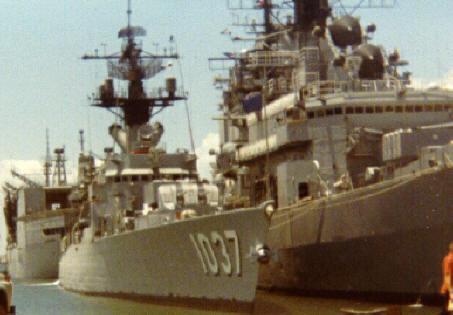 |
As pictured at left, the
USS BRONSTEIN (DE-1037) seen docked next to the LEAHY class DLG, USS
BAINBRIDGE.
BRONSTEIN was laid down by Avondale Marine, Avondale L.A. on
May 16, 1961, launched March 31, 1962, with commissioning on June 15, 1963
she was re-classified a Frigate (FF-1037) on June 30, 1975. She was
eventually decommissioned and stricken on December 13, 1990 and sold to
Mexico on October 1, 1993 and subsequently renamed "HERMENEGILDO GALEANA
(E-42)"
As of March 2003, BOTH Bronstein class
vessels operated out of the Mexican Navy's Pacific Headquarters Base at
Manzanillo, Mexico.
The Mexican Navy has renumbered their frigates and some
other ships during CY 2002. Also, the prefix "ARM" has been added to each
ship name, just as the U.S. Navy employs the prefix "USS". The hull
designation "F" for frigate is now used instead of "E" for escort.
Thus, last year BRONSTEIN was
renumbered to "ARM HERMENEGILDO GALEANA (F202)"
|
|
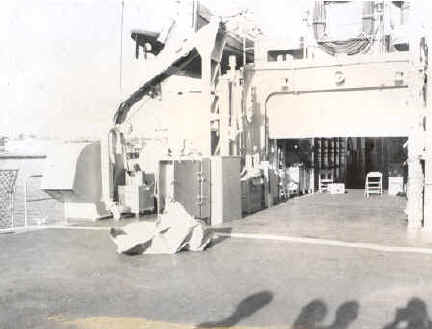 |
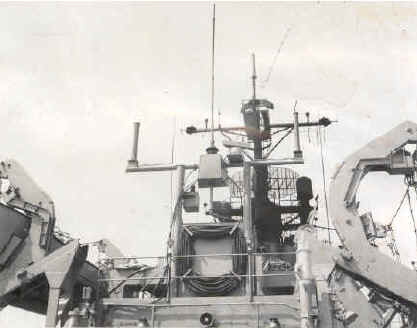 |
Above, is the BRONSTEIN's flight deck. The Flight Deck
Station was the guiding activity for the QH-50 drone during visual
portions of the flight. On the BRONSTEIN, the deck control station
is at left or on the port side. While BRONSTEIN was built this way, others
destroyers that were FRAM'd to receive a flight deck and control
station also involved the
placement of the deck control station on the right side or Starboard side.
Almost EVERY FRAM installation/reconstruction was a custom installation
due to the various classes of ship involved as well as differing
manufacturers and the various ship yards performing the FRAM
modifications.
|
As on other FRAM Destroyers and Destroyer Escorts,
the mast assembly changed during FRAM as the DASH antenna's were
installed. There were two antenna's- one for the fore (forward) and one
for the aft (rear) of the ship. On the Transmitter control panel at the
deck and CIC stations, the operator had the capability of selecting which
antenna to use, relative to the Drone's position, to maintain maximum
control capability of the Drone.
|
|

|
Above, the USS Bronstein
(DE-1037) in dry dock at San Diego showing the massive
SQS-26 bow mounted sonar being installed around December 5, 1963. This
sonar gave the detection range required for the DASH weapon
system to be used to its designed ASW range- out to 20,000 yards
(over 11 miles from ship).
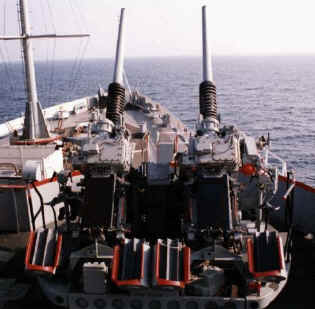 The BRONSTEIN (operated in Pacific Fleet) and sister ship USS McCLOY (DE-1038)
(operated in Atlantic Fleet) were both originally
built with the original SQS-26 bow mounted sonar while older destroyers
undergoing FRAM received the SQS-23 system. The Bronstein
class of Destroyer Escorts were the smallest ships that could carry the
SQS-26 sonar when they were commissioned in 1963 and in fact were purpose-built
to
The BRONSTEIN (operated in Pacific Fleet) and sister ship USS McCLOY (DE-1038)
(operated in Atlantic Fleet) were both originally
built with the original SQS-26 bow mounted sonar while older destroyers
undergoing FRAM received the SQS-23 system. The Bronstein
class of Destroyer Escorts were the smallest ships that could carry the
SQS-26 sonar when they were commissioned in 1963 and in fact were purpose-built
to 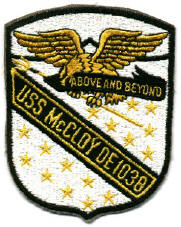 be test beds for the installation. They represented a halfway step between the
small Dealey class and the larger Garcias class of Destroyer Escorts. The
Bronstein class incorporated the same 600 PSI engineering plant as the Dealeys, but
interestingly even though they were considerably larger, they were
slightly faster than the DEALEY's as well, probably because the
large bow-mounted sonar gave them a more efficient hull form. The original
sonar systems were miserably unreliable and the SQS-26 AX installed in the Garcias wasn't much better. be test beds for the installation. They represented a halfway step between the
small Dealey class and the larger Garcias class of Destroyer Escorts. The
Bronstein class incorporated the same 600 PSI engineering plant as the Dealeys, but
interestingly even though they were considerably larger, they were
slightly faster than the DEALEY's as well, probably because the
large bow-mounted sonar gave them a more efficient hull form. The original
sonar systems were miserably unreliable and the SQS-26 AX installed in the Garcias wasn't much better.
In the summer of 1967, USS McCLOY returned to
dry dock to receive the SQS-26 AX (R) (major retrofit).....both she and
BRONSTEIN went straight from SQS-26 to SQS-26 AX(R) without getting the AX
variant.
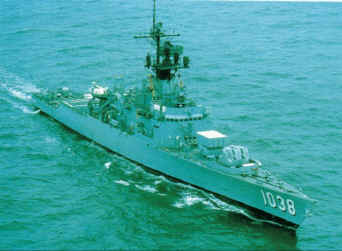 This system was more reliable, but the BRONSTEIN class
was really too
small for this sonar system. The equipment rooms filled the entire forward 1/3 of
the ship and
the crew couldn't fire their forward 3"/50 (twin) Mk 33 guns (seen
above-right) without dropping
the sonar off the line. The preceding top of the line system was the SQS-23,
but the SQS-26 did NOT evolve from the -23.....it was a completely new design to take advantage of bottom-bounce and convergence zone modes. This system was more reliable, but the BRONSTEIN class
was really too
small for this sonar system. The equipment rooms filled the entire forward 1/3 of
the ship and
the crew couldn't fire their forward 3"/50 (twin) Mk 33 guns (seen
above-right) without dropping
the sonar off the line. The preceding top of the line system was the SQS-23,
but the SQS-26 did NOT evolve from the -23.....it was a completely new design to take advantage of bottom-bounce and convergence zone modes.
With the history of BRONSTEIN above taken into
consideration, the USS McCLOY (the
only other BRONSTEIN class DE-seen at left) suffered the same fate:
After she was reclassified as a Frigate (FF-1038) on June 30, 1975, she
was decommissioned on December 14, 1990, stricken December 17, 1990 and
sold to Mexico on October 1, 1993 (along with
BRONSTEIN) and renamed "NICHOLAS BRAVO (E-40)".
As of March 2003, McCLOY still serves in
the Mexican Navy as ARM NICHOLAS BRAVO (F201).
|
Many thanks to the former Sailors of the
USS BRONSTEIN and McCLOY for operational information of their ships and
also to
The United States Navy's Program Executive Office, Ships, Navy Inactive
Ships Program Office-PMS333 ,
The Ship Transfer and Ship Systems Division (PMS3804) and
The Security Assistance Program Office (PMS380)
for providing past
and current operational data on the BRONSTEIN Class of DASH equipped
Destroyer Escorts!

           

|

![]()
![]()
![]()
![]()